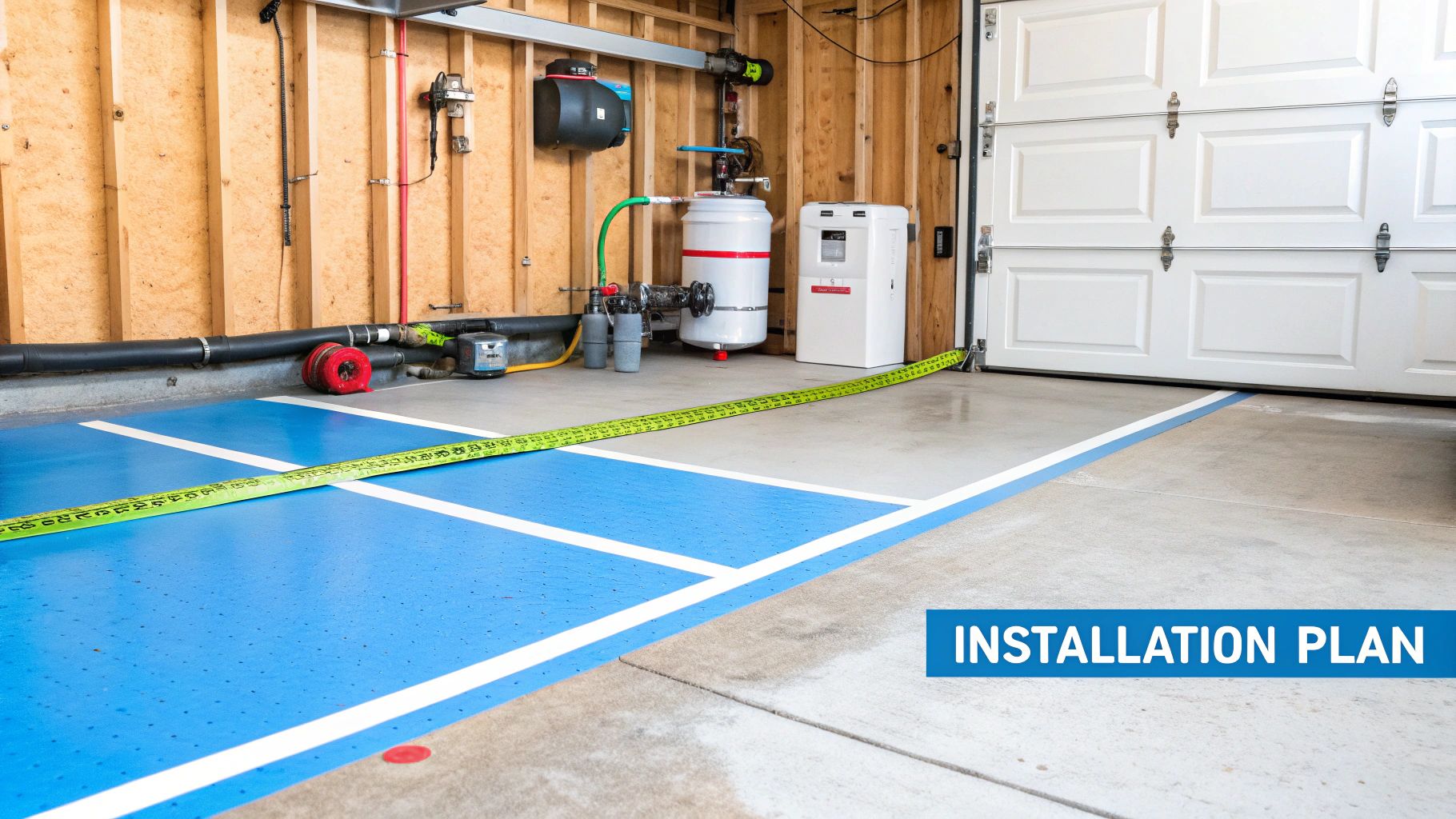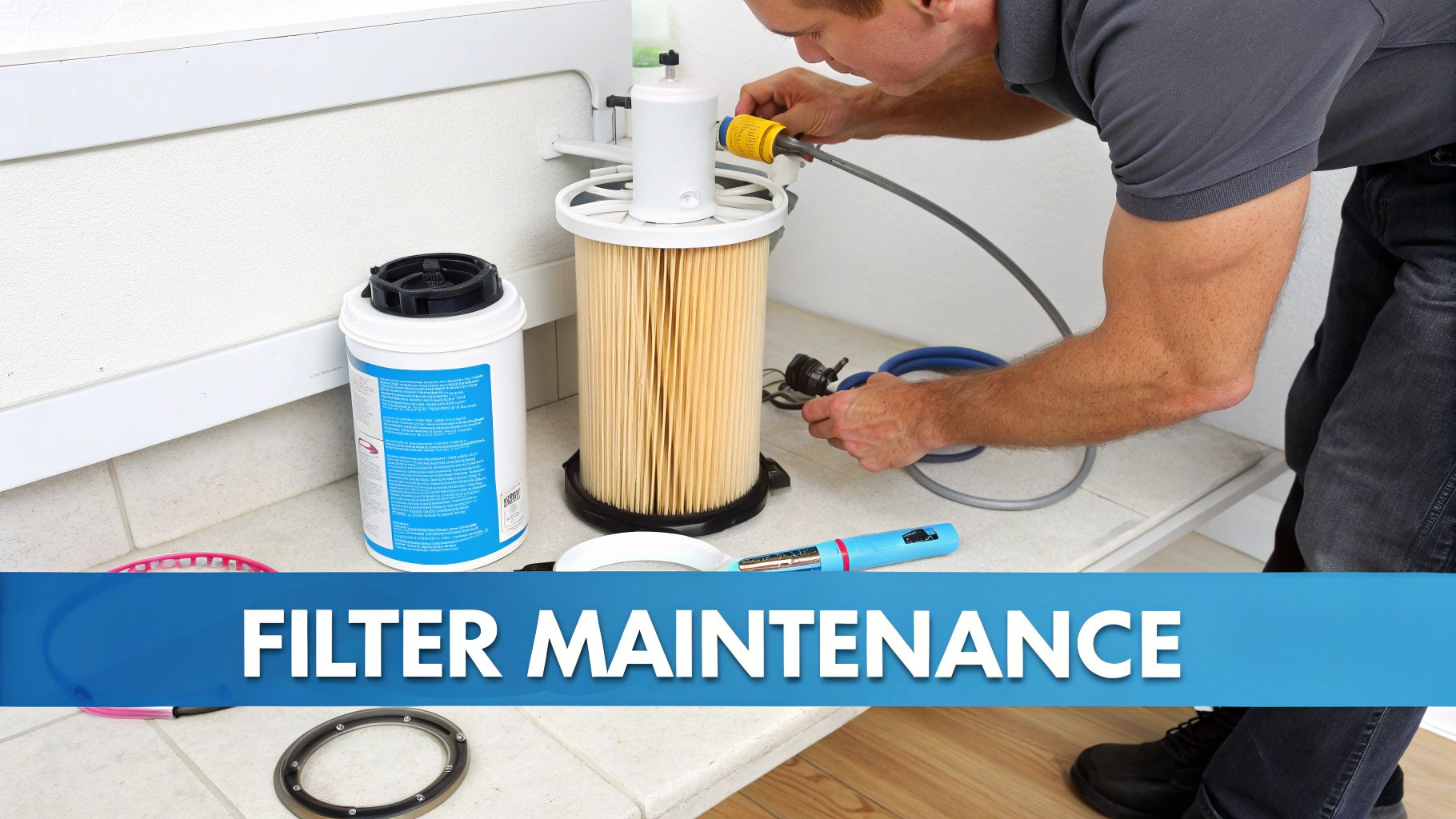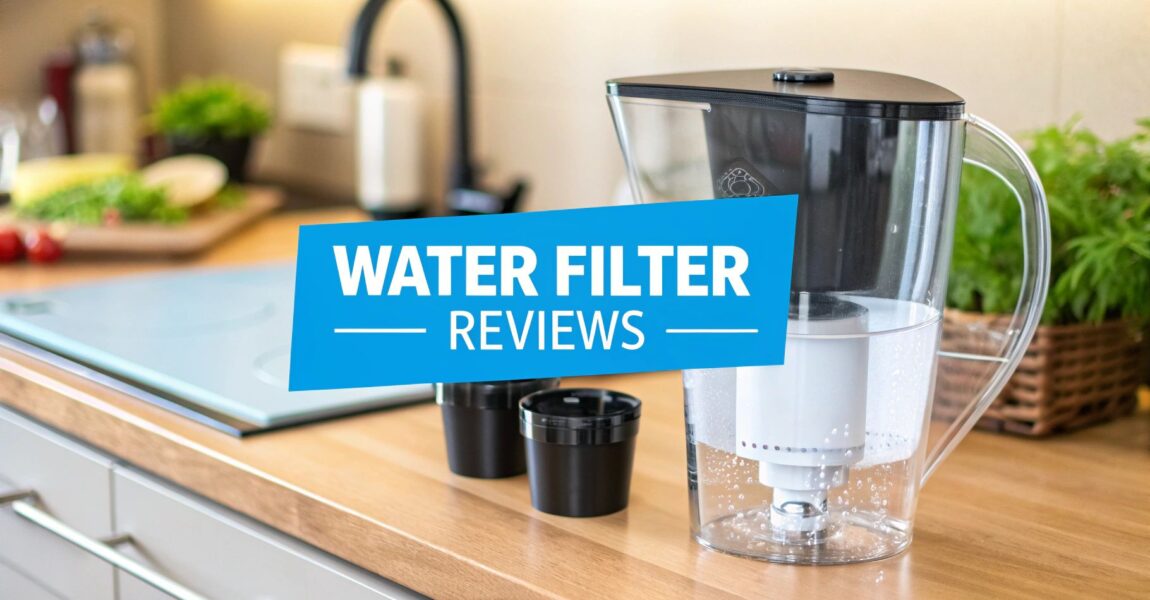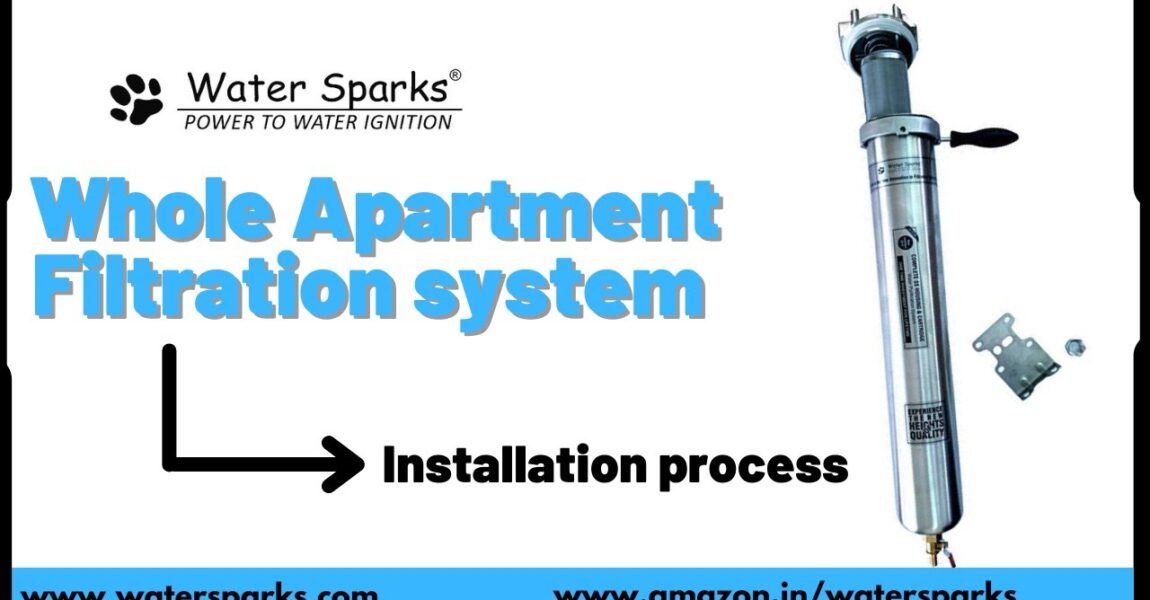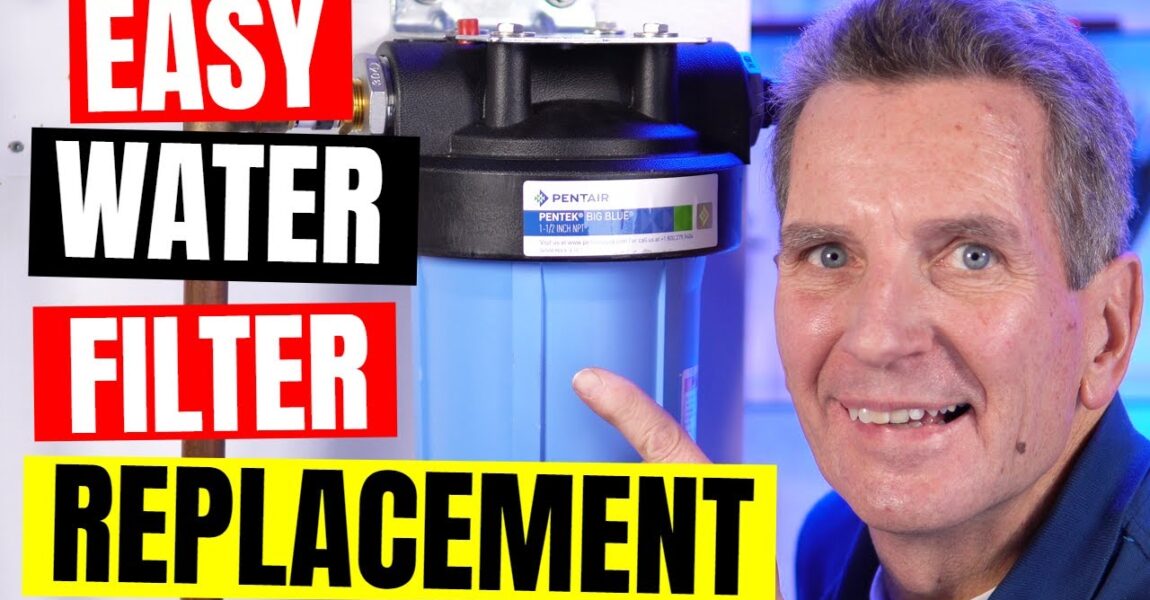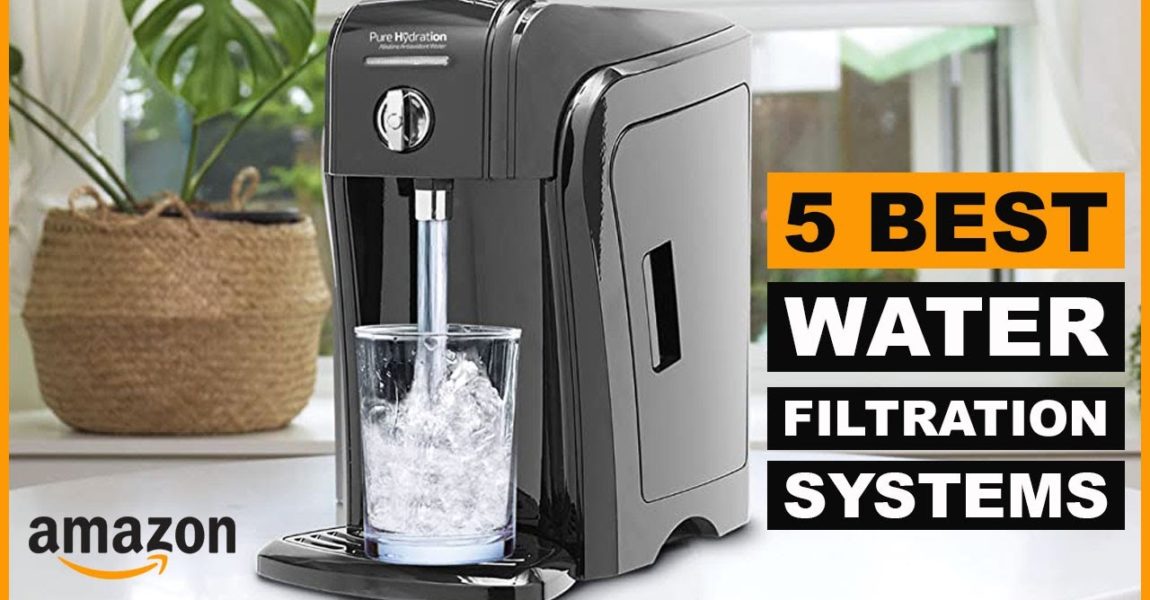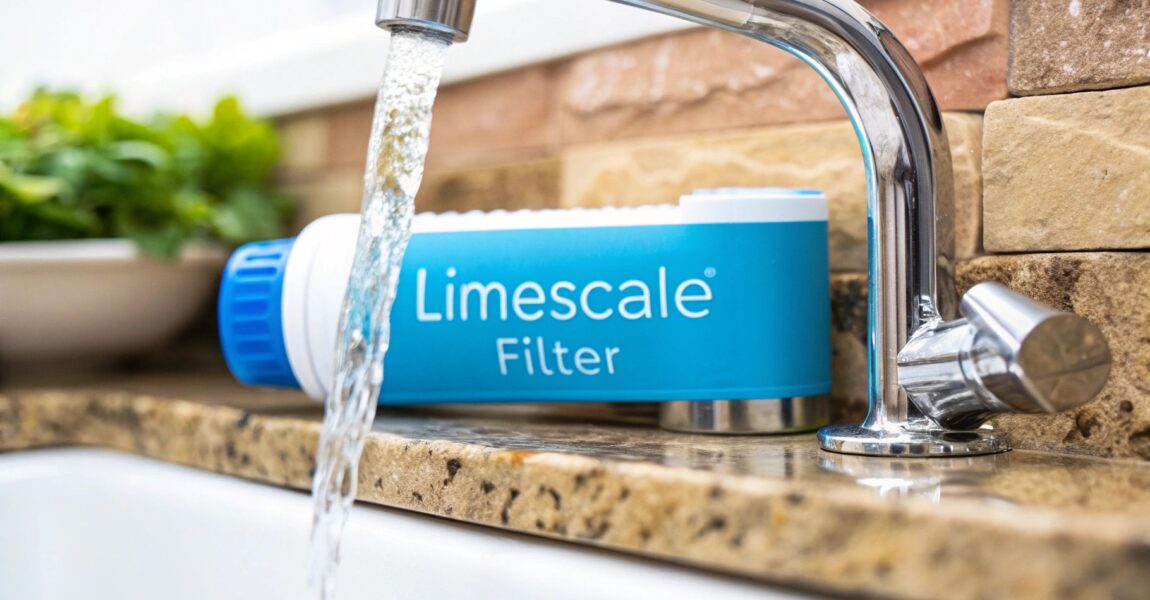
Your Guide to Winning the War on Limescale
That chalky white gunk on your showerhead? It’s just the tip of the iceberg—the most visible sign of a much bigger, more expensive problem lurking in your pipes. To truly defeat the limescale dragon, you need a whole-house system that treats the water before it ever has a chance to cause chaos. The best water filters for limescale typically use ion exchange (the classic water softener) or template-assisted crystallization (a modern, salt-free conditioner).
This guide will walk you through everything you need to know to find the right solution and protect your home from the costly damage caused by hard water.
The Hidden Damage Limescale Causes in Your Home
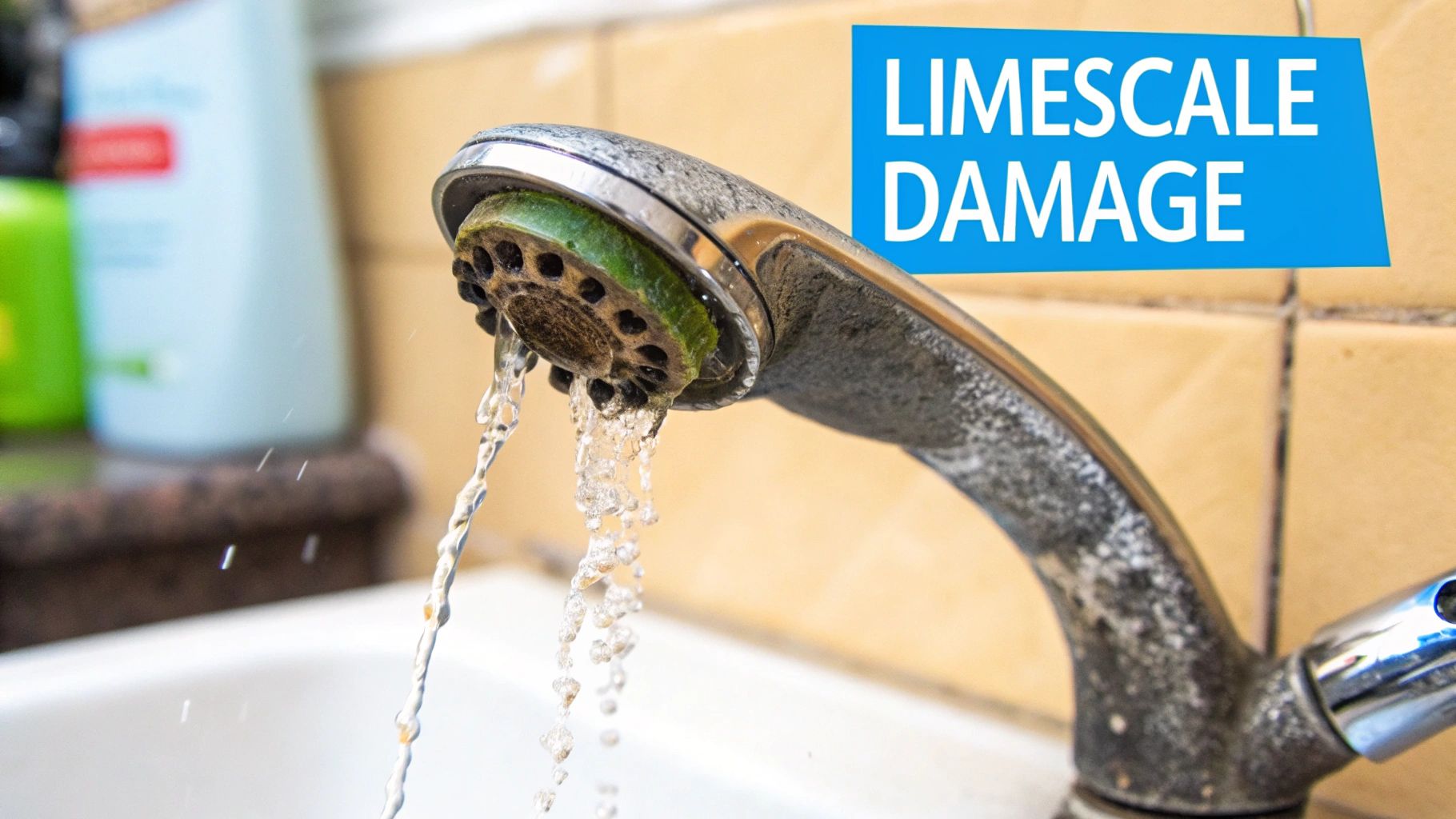
If you’ve ever pulled a supposedly clean glass from the dishwasher only to find it covered in cloudy spots, you've seen limescale in action. This chalky substance is the silent villain that comes with hard water, slowly but surely wrecking things from the inside out. It's the real reason your coffee maker sputters to a stop or your shower pressure weakens to a sad little trickle.
These daily frustrations are warning signs of a deeper issue. Limescale is just the hardened deposits of minerals—mainly calcium and magnesium—that are naturally in your water. When that hard water gets heated or simply evaporates, these minerals get left behind, baking into a rock-hard coating on any surface they touch.
More Than Just a Cleaning Nuisance
Sure, visible scale on your faucets is ugly and annoying, but the real trouble is the damage you can't see. Limescale is relentlessly building up inside your pipes and appliances, setting off a chain reaction of expensive and frustrating problems.
This internal buildup forces your home's most important equipment to work way harder than it should. Picture your water heater trying to heat water through a thick layer of mineral scale; it's like trying to cook with a pan coated in cement. The result is a ton of wasted energy and a much higher utility bill. In fact, just a quarter-inch of scale can crank up a water heater's energy use by a shocking 40%.
"Limescale can make your coffee taste flat and reduce the lifespan of your coffee and steam equipment. If you don’t keep it out of your equipment, it causes problems such as inconsistent temperatures and premature breakdown."
Ignoring limescale has some serious consequences. This mineral buildup can lead to:
- Reduced Appliance Efficiency: Everything from your dishwasher to your washing machine has to fight against scale, leading to poor performance and, eventually, total failure.
- Clogged Pipes: Over time, scale can literally narrow your pipes, strangling your water flow and killing the pressure throughout your house.
- Higher Energy Bills: Your water heater and other appliances have to burn more electricity or gas just to do their basic job.
- Costly Repairs: The delicate internal parts of appliances like espresso machines and washing machines are especially vulnerable. Unfiltered hard water is a primary cause of leaks and breakdowns.
The good news is, you don't have to put up with it. Understanding what limescale is doing to your home is the first step. The next is figuring out how the right water filter for limescale can protect your investments, save you money, and bring back some peace of mind. This guide will show you exactly how.
So, What Exactly Is Limescale and Where Does It Come From?
Before you can tackle a problem, you’ve got to know what you’re dealing with. When it comes to hard water, the science behind that frustrating, chalky gunk is actually pretty straightforward.
Think about what happens when you dissolve a spoonful of sugar in hot tea. If you let the tea evaporate, you'd find a sticky layer of sugar crystals left behind in the cup. Limescale works on a very similar principle.
Your home’s water naturally contains dissolved minerals, mostly calcium and magnesium. When this "hard water" gets heated up in your boiler or evaporates off a surface like your shower door, the water leaves, but the minerals stay. They then crystallize and fuse together, creating that tough, crusty deposit we all know as limescale.
This is just basic water chemistry in action, but the havoc it wreaks on your home is anything but harmless. The scale you can see on your faucets is just the tip of the iceberg—the real damage is happening where you can't see it.
The Hidden Costs of Mineral Buildup
Limescale isn't just ugly; it’s an expensive pest that slowly but surely destroys your home’s plumbing and appliances. The mineral buildup acts like a layer of insulation, forcing your water heater and other appliances to work much harder just to do their job. That inefficiency hits you right where it hurts: your utility bills.
Even worse, this constant strain can cause major—and sometimes catastrophic—damage over time.
- Skyrocketing Energy Bills: Your water heater has to burn way more energy to push heat through a thick layer of mineral scale. A buildup of just 1/4 inch can jack up a boiler's energy consumption by a shocking 40%.
- Shorter Appliance Lifespan: The guts of your dishwasher, washing machine, and coffee maker get clogged and corroded. This leads to premature breakdowns and unexpected replacement costs.
- Clogged Pipes and Weak Water Pressure: Over the years, limescale can choke the life out of your pipes, narrowing their diameter and leading to frustratingly low water pressure throughout your house.
- Poor Performance: You'll start to notice your dishwasher leaves cloudy spots on glasses and your washing machine just doesn't get clothes as clean. Even your morning coffee can taste flat because the water can't properly extract the flavor from the beans.
Limescale acts as a barrier, forcing the boiler to work harder to heat the water. This leads to premature aging of the equipment and, eventually, breakdown.
How to Spot the Signs of Hard Water
Before picking the right water filter for limescale, you need to be sure you actually have a problem. Luckily, hard water usually leaves plenty of clues. If you see any of these signs, you’re almost certainly dealing with limescale.
- White, chalky residue on faucets, showerheads, and around drains.
- Soap scum that seems to instantly reappear on shower doors, tubs, and sinks.
- Cloudy spots on your dishes and glassware right after they come out of the dishwasher.
- Stiff, scratchy laundry and faded clothes, since mineral deposits get trapped in the fabric.
- Dry skin and dull, lifeless hair from the residue left behind after you shower.
It's no surprise that the market for effective solutions is booming. Filters designed to fight limescale are a huge part of the global water filters market, which hit a value of USD 16.16 billion in 2024 and is expected to more than double by 2033. This growth is happening because more and more people are realizing how much damage hard water does to their homes. You can explore more data on this market trend to see just how big the issue is.
Comparing The Different Types of Limescale Filters
Trying to figure out the world of limescale solutions can feel a bit like learning a new language. You’ll hear terms like softeners, conditioners, and descalers thrown around, each promising to put an end to your hard water headaches. The secret to picking the right water filter for limescale is really just understanding what’s happening behind the scenes.
The main difference comes down to how each system deals with the hard minerals in your water. Some straight-up remove them, while others just change their behavior so they can’t build up and cause problems. Let's dig into the three main players in the fight against scale.
To really see what these filters are up against, just look at the journey from hard water to a broken appliance.
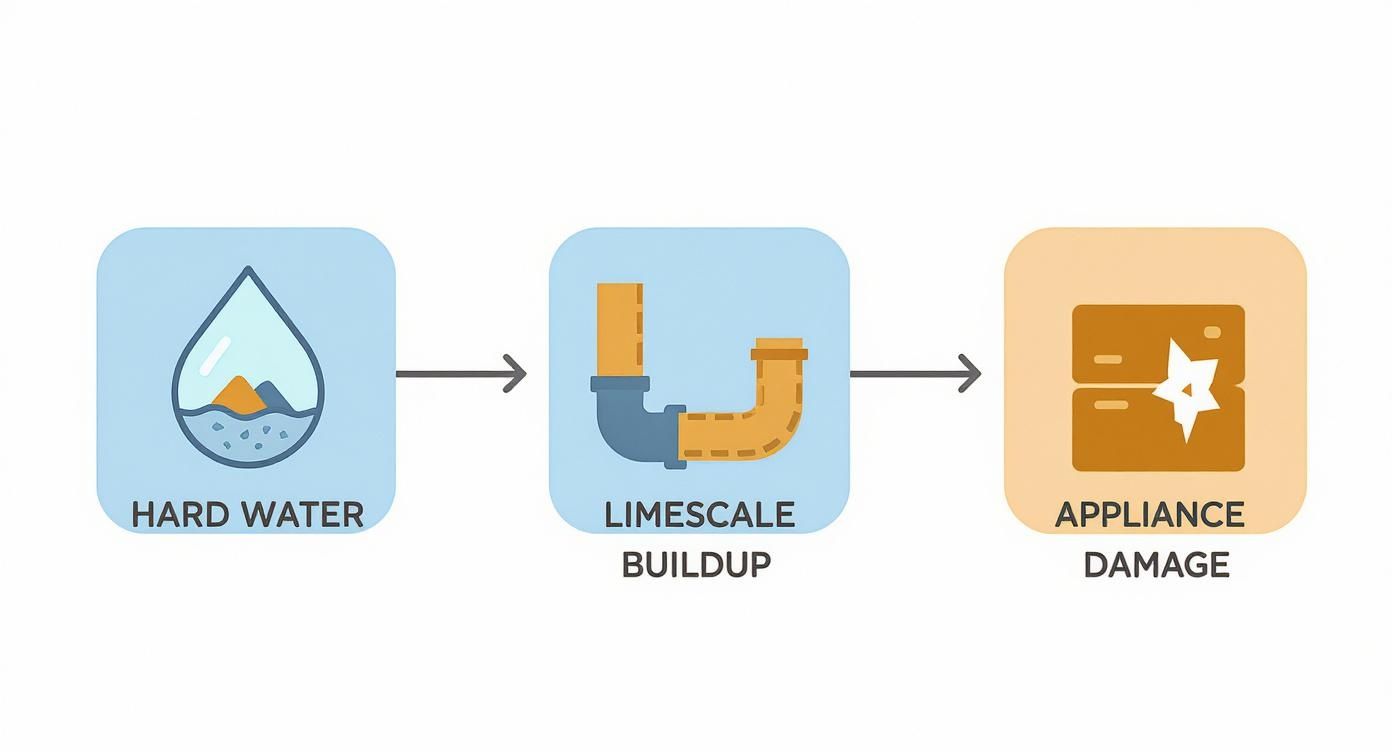
This pretty much sums it up: untreated hard water leads directly to that crusty limescale, which eventually causes some pretty expensive damage to your home’s most important appliances.
Salt-Based Water Softeners: The Mineral Swap
This is the old-school, traditional workhorse of limescale treatment. A salt-based water softener works using a process called ion exchange, which is basically a swap meet for minerals.
Think of your hard water as a stream full of clingy little calcium and magnesium particles. Inside the softener tank, there are thousands of tiny resin beads covered in sodium ions. As the water rushes past, the calcium and magnesium—which are like stronger magnets—bump the sodium ions out of the way and grab onto the beads instead. The sodium gets released into your water, and the hard minerals get trapped. Simple as that.
This is the only method that actually removes the hardness minerals, giving you truly soft water. It’s the reason you get that slick, slippery feeling in the shower—there are no minerals left to form that annoying soap scum.
- How It Works: Uses ion exchange to swap hardness minerals (calcium and magnesium) for sodium ions.
- The Result: Genuinely soft water without any of the minerals that form scale.
- Maintenance: You'll need to regularly top up the brine tank with salt pellets so the system can "regenerate" and clean off the resin beads.
Salt-Free Water Conditioners: The Non-Stick Shield
If you’re looking for a solution that doesn’t add any salt to your water, a salt-free water conditioner is a great way to go. These systems don't technically "soften" the water or pull any minerals out. What they do is change the physical structure of the minerals so they can't stick together and form scale.
Imagine coating a sticky piece of candy with a fine, non-stick powder. The candy’s still there, but it won’t clump up or stick to anything. That’s essentially what Template Assisted Crystallization (TAC) does. The media inside the tank grabs the hardness minerals and forces them into tiny, stable crystals that just float on by.
These microscopic crystals are harmless and flow right through your plumbing without clinging to pipes or heating elements. You get to keep the healthy calcium and magnesium in your water, but without the destructive scale.
It's important to remember that salt-free systems prevent scale; they don't remove hardness. Your water will still test as "hard," but it will act like soft water where it counts.
Electronic and Magnetic Descalers: The Structural Shake-Up
The third category is electronic or magnetic water descalers. You’ll usually see these devices clamped or wrapped around the outside of your main water pipe, never actually touching the water itself.
The idea here is that they generate a magnetic or electronic field that passes through the pipe. This field is meant to shake up the calcium and magnesium minerals, changing their crystal structure. Much like TAC systems, the goal is to make the minerals less sticky and less likely to build up on surfaces.
These are often the easiest systems to install and have zero ongoing maintenance. That said, their effectiveness is a hot topic of debate. Results can vary a lot depending on your home’s specific water chemistry and flow rate, so they're generally seen as a scale prevention tool, not a complete fix.
It's no surprise that all these technologies are gaining traction. The global water filter market, which covers everything from limescale to microbes, was valued at around US$48.2 billion in 2025. It’s expected to shoot up to US$84.2 billion by 2032, largely because people are more aware of water quality and want to protect their homes. You can get more details on water filter market growth from Persistence Market Research.
To make the choice a little easier, here’s a quick rundown to help you compare the different approaches.
Comparing Limescale Filtration Technologies
This table breaks down the key differences between the main limescale treatment methods, giving you a clear side-by-side look at what each one offers.
| Technology Type | How It Works | Best For | Key Advantage | Main Disadvantage |
|---|---|---|---|---|
| Salt-Based Softener | Ion Exchange: Swaps calcium/magnesium for sodium. | Homes with very hard water needing total mineral removal. | Completely removes hardness, eliminating soap scum and scale. | Adds sodium to water; requires ongoing salt refills. |
| Salt-Free Conditioner | Template Assisted Crystallization (TAC): Crystallizes minerals. | Eco-conscious homes wanting scale prevention without salt. | Prevents scale buildup while preserving healthy minerals. | Does not technically "soften" water or reduce soap scum. |
| Electronic Descaler | Magnetic/Electronic Field: Alters mineral structure. | Renters or those seeking a low-maintenance, non-invasive option. | Easy DIY installation and zero ongoing maintenance. | Effectiveness can be inconsistent and is debated. |
Hopefully, this gives you a better handle on which technology might be the best fit for your home and your water.
How to Choose the Right Limescale Filter for Your Home
Alright, now that we've covered the different technologies, let's move from theory to practice. Choosing the right water filter for limescale isn't about finding some mythical "best" filter—it’s about finding the best one for your home and your water.
A few key factors will help you narrow down the choices and pick a solution you can be confident in. Before you can choose your weapon, you need to know the size of the dragon you're fighting.
Assess Your Water Hardness Level
First things first: you absolutely need to know how hard your water is. This is the single most important piece of the puzzle, as it dictates how aggressive your solution needs to be. You can easily grab a DIY water hardness test kit online or from any big-box home improvement store.
These kits measure hardness in Grains Per Gallon (GPG). Here’s a quick breakdown of what the numbers mean:
- Slightly Hard: 1 to 3.5 GPG
- Moderately Hard: 3.5 to 7 GPG
- Hard: 7 to 10.5 GPG
- Very Hard: Over 10.5 GPG
If your test results come back in the "Hard" or "Very Hard" range, a salt-based water softener is almost always your best bet. It’s the only way to truly remove the minerals causing all the trouble. For moderately hard water, a salt-free conditioner can be a fantastic, low-maintenance alternative.
Whole House Protection vs. Targeted Treatment
Next up, you need to decide on the scope of your protection. Are you looking to protect your entire home's plumbing and every appliance, or are you just trying to fix a specific problem? This is the classic battle between Point-of-Entry and Point-of-Use systems.
Point-of-Entry (POE) systems, often called whole-house filters, are installed right where the main water line enters your home. This means every single drop of water—for your shower, washing machine, dishwasher, and faucets—gets treated. It’s the ultimate defense for your entire plumbing system.
Point-of-Use (POU) systems are much smaller and treat water right where you use it. Think of a dedicated showerhead filter or a little inline filter you’d hook up to your coffee machine. These are perfect for renters or for tackling a single problem without the cost and installation of a whole-house unit. For more general filtration guidance, you can find a ton of helpful advice on our site.
It's no surprise that more and more people are looking for comprehensive solutions. The whole-house water treatment market was valued at a whopping USD 10.17 billion in 2024 and is expected to climb to USD 13.42 billion by 2030. This boom shows just how many people are realizing the importance of tackling hard water at its source. You can dig into more market insights over at Grand View Research.
The choice between POE and POU really boils down to your main goal. Are you protecting your home's infrastructure, or just trying to stop a pesky, scale-clogged showerhead?
Matching the Filter to Your Lifestyle
Let's get practical. Your family size, living situation, and what you care about most will steer you toward the perfect limescale filter.
Scenario 1: The Family Homeowner
- The Problem: A family of four owns a house in a very hard water area (12 GPG). They’re fed up with spotty dishes, crunchy laundry, and have already paid to replace one water heater.
- The Solution: A whole-house, salt-based water softener (POE) is the clear winner here. It will completely eliminate the hardness minerals, protecting their expensive appliances and making daily life so much easier. The long-term savings on repairs and energy bills will more than pay for the initial investment.
Scenario 2: The Apartment Renter
- The Problem: A couple rents an apartment where the water is moderately hard (6 GPG). They can't make any permanent changes to the plumbing but want to stop the scale buildup on their showerhead and get rid of that slimy soap scum.
- The Solution: A high-quality Point-of-Use (POU) showerhead filter is the perfect fit. It’s a breeze to install and remove, doesn't require a plumber, and directly solves their biggest annoyance. They could even add another POU filter for their kitchen sink if they wanted to.
By working through these steps—testing your water, deciding on scope, and thinking about your lifestyle—you can confidently pick a limescale filter that actually fits your needs, budget, and home.
Installing and Maintaining Your Limescale Filter

You’ve done the research and picked out the perfect water filter for limescale. That’s a huge step, but the job isn't quite done. A filter is only as good as its installation and upkeep, and getting this part right ensures your system runs like a dream for years to come.
Some systems are genuinely plug-and-play. Point-of-use filters, like a descaling showerhead, are often designed for anyone to install. You can usually just screw it on by hand in a few minutes, no tools needed. It's a fantastic, targeted fix.
Whole-house systems, though? That's a different league. Whether it's a salt-based softener or a salt-free conditioner, you're looking at a proper plumbing job. It means shutting off your home's main water supply and cutting into the primary pipe. For that kind of work, calling a licensed plumber is nearly always the smartest, safest move.
What a Typical Installation Involves
Even if you hire a pro, it helps to know what to expect. While every house is a little different, the general playbook for a whole-house system is pretty standard.
- Find the Right Spot: The unit needs to go near your main water shut-off valve, usually tucked away in a garage, basement, or utility closet. It needs a level floor and, for softeners, access to a drain.
- Turn Off the Water: First things first, the main water supply to the house gets shut off. The plumber will then drain the pipes to release any pressure.
- Cut the Main Line: This is the point of no return. A section of the main water line is carefully cut out to make room for the new system.
- Install the Bypass Valve: A bypass valve is a must-have. This clever bit of plumbing lets you shut off water to the filter for maintenance without turning your whole house into a desert.
- Connect the System: The filter tanks are then connected to the bypass valve. A secure, leak-proof fit is absolutely critical here.
- Set Up the Drain Line: For water softeners, a drain line has to be run from the control valve to a nearby drain, like a laundry sink or standpipe. This is for the regeneration cycle.
- Fire It Up: With everything connected, the water is slowly turned back on. The plumber will meticulously check for leaks and run the system through its first cycles to make sure it's working perfectly.
Creating a Maintenance Routine
Once your filter is humming along, a simple maintenance schedule is your ticket to long-term success. What you need to do really depends on the type of system you chose.
A well-maintained limescale filter doesn't just protect your pipes and appliances; it guarantees you're getting the best quality water your system can deliver. Think of it as an investment in your home and your daily comfort.
Here’s a quick rundown of what to expect for each type:
- Salt-Based Water Softeners: These are the most hands-on. You'll need to check the salt level in the brine tank at least once a month and top it off as needed. While modern systems are pretty efficient, plan on adding a 40-pound bag of salt every couple of months.
- Salt-Free Water Conditioners: The beauty of these systems is how little they ask of you. The internal media that conditions the water has a long lifespan, typically only needing a replacement every 3 to 6 years. No salt bags, no fuss.
- Electronic Descalers: This is the true "set it and forget it" option. Once it's clamped onto your pipe and plugged in, there is virtually zero maintenance.
Don't forget your appliances! Regular cleaning is key to tackling any scale that built up before your filter was installed. For example, learning how to clean your washing machine to remove limescale can boost its performance and help it last longer. A clear schedule for both your filter and your appliances ensures you get every bit of value from your investment.
Putting an End to Limescale for Good
Limescale can feel like a never-ending battle, but it’s one you can absolutely win. Now that you’ve seen how it forms, the sneaky damage it does, and the different technologies out there to fight it, you have everything you need to pick the right water filter for limescale for your home.
You know the difference between a water softener that gets rid of hard minerals and a conditioner that just stops them from sticking. That's the key to choosing a system that fits your water, your family's size, and what you want to spend.
This isn't just about getting rid of those annoying white spots. It's about protecting your expensive appliances, cutting down your energy bills, and getting better, cleaner water from every tap in your house.
So, what's the first step? It's simple: test your water. You can't find the right solution if you don't know exactly what problem you're solving. As you get started, it might also be helpful to look into other home water treatment solutions to see the full picture.
Don't wait for the problem to get worse. You can start today and finally free your home from the expensive headaches limescale causes.
Limescale Filter FAQs
Even after getting the rundown on the tech, you probably still have a few questions floating around. That’s perfectly normal. Here are some quick, straightforward answers to the questions we hear most often.
Will a Limescale Filter Make My Water Safer to Drink?
Not really. Think of limescale filters as specialists. Their one and only job is to go after the minerals that make your water hard—not things like bacteria, lead, or chlorine. The water that comes out is perfectly fine to drink, but it hasn't been "purified."
If you want to improve the actual safety and taste of your drinking water, you'll need to pair your limescale system with a dedicated drinking water filter. A reverse osmosis system, for instance, is fantastic for purification and plays very nicely with a whole-house softener or conditioner.
How Long Does a Limescale Filter Last?
This completely depends on the type of system you choose. The lifespan can vary wildly, so it’s a huge factor when you're thinking about long-term costs and upkeep.
- Salt-Based Water Softeners: The resin tank is the workhorse of these systems. With good care, it can easily last 10 to 20 years.
- Salt-Free Conditioners: These are pretty low-maintenance, but the internal media that handles the crystallization will need to be swapped out, usually every 3 to 6 years.
- Electronic Descalers: Since nothing inside actually touches the water, these gadgets can last for ages with literally zero maintenance.
- Point-of-Use Filters: Smaller filters, like the one on your showerhead, have a much shorter run. Expect to change the cartridge every 3 to 6 months.
When you're looking at a system's lifespan, don't just focus on the sticker price. You have to consider the total cost of ownership over its entire life. A more durable system often ends up being the better value.
Can I Install a Whole-House Limescale Filter Myself?
This one comes down to your own comfort level with plumbing. If you're a seasoned DIYer, you could probably tackle a simple inline system. But for most whole-house softeners and conditioners, it's really a job for a pro.
These installations mean cutting into your home's main water line. It's the kind of job where a tiny mistake can lead to some seriously big leaks and water damage. Bringing in a licensed plumber just makes sure it's done right, meets local codes, and lets you sleep at night.
Ready to find the perfect solution for your home? The team at Water Filter Advisor has done the research for you, with in-depth reviews and practical guides to help you choose with confidence. Explore our expert advice and product comparisons at https://www.waterfilteradvisor.com.

